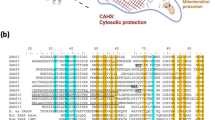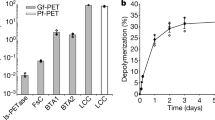Abstract
IN recent studies on the physiology of ripening in fruits, attention has been focused on the possible relationship between phosphorylative processes and the climacteric rise in respiration1–3. Since many respiratory enzymes are located in the mitochondria, the isolation of these subcellular units in an active state is of great importance in such investigations. Although the apple is the classic object for studies in fruit physiology, attempts to prepare particulate fractions with mitochondrial activity from apples have not been successful. Lieberman4 isolated particles with cytochrome oxidase activity by grinding apples in a medium containing tris-hydroxy-methyl aminomethane at pH. 9.2. By using a homogenizing medium buffered at pH 7 with 0.5 M phosphate, Neal and Hulme5 obtained apple particles which oxidized succinate and malate to a slight extent, but only in the presence of the phenolic compound protocatechuic acid. Pearson and Robertson2 isolated apple particles that had a high endogenous oxygen uptake and that showed some oxidative activity with succinate, citrate and malate. Pearson and Robertson's2 particles were obtained after a single centrifugation of the homogenate and possibly contained contaminating phenolic compounds. These compounds may have contributed in part to the endogenous oxygen uptake and, in the light of Neal and Hulme's5 results, may also have been responsible for the oxidation of the added acids. In all these studies, stress has been laid on the necessity for counteracting the high acidity of the tissue when preparing mitochondria from apples.
This is a preview of subscription content, access via your institution
Access options
Subscribe to this journal
Receive 51 print issues and online access
$199.00 per year
only $3.90 per issue
Buy this article
- Purchase on Springer Link
- Instant access to full article PDF
Prices may be subject to local taxes which are calculated during checkout
Similar content being viewed by others
References
Millerd, A., Bonner, J., and Biale, J. B., Plant Physiol., 28, 521 (1953).
Pearson, J. A., and Robertson, R. N., Austral. J. Biol. Sci., 7, 1 (1954).
Romani, R., and Biale, J. B., Plant Physiol., 32, 662 (1957).
Lieberman, M., Science, 127, 189 (1958).
Neal, G. E., and Hulme, A. C., Nature, 181, 1469 (1958).
Tager, J. M., S. African J. Sci. (in the press).
Author information
Authors and Affiliations
Rights and permissions
About this article
Cite this article
TAGER, J. Isolation of Active Mitochondria from Apples. Nature 182, 1521–1522 (1958). https://doi.org/10.1038/1821521b0
Issue Date:
DOI: https://doi.org/10.1038/1821521b0
This article is cited by
Comments
By submitting a comment you agree to abide by our Terms and Community Guidelines. If you find something abusive or that does not comply with our terms or guidelines please flag it as inappropriate.



